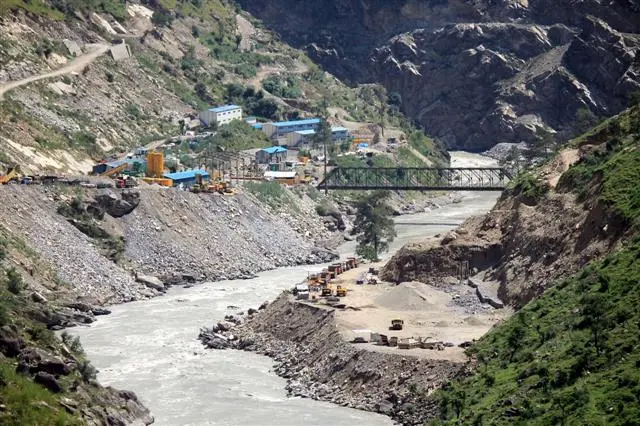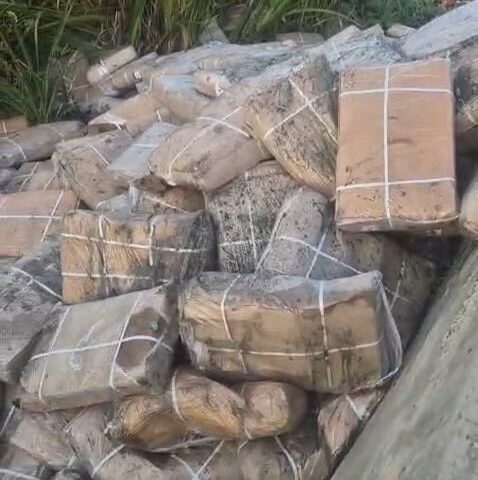Deforestation, Encroachments Blamed for Recurring Flood Scares in Kashmir; Ratle Power Project Landslide Brings Kashmir’s Fragile Ecology into Focus
By: Javid Amin | 04 Sep 2025
Ratle Landslide: A Narrow Escape
On September 4, 2025, disaster struck at the Ratle Power Project site in Kishtwar’s Dhrabshala area when a sudden landslide swept down a rain-soaked slope. Temporary tin sheds, being used as washrooms by workers, were buried under a torrent of earth and rock. Five workers were trapped inside.
The district administration, led by Deputy Commissioner Pankaj Sharma, launched an immediate rescue operation. In a tense two-hour effort, all five were pulled out alive. Three of them, however, sustained serious injuries and were rushed to GMC Doda.
The incident could easily have been a major tragedy. It highlights the fragile ecology of the Chenab Valley, where dozens of hydroelectric projects, including Ratle, are being developed on some of the most landslide-prone slopes in the Himalayas.
“We were lucky this time. But if landslides like this happen again, we may not be so fortunate,” said a worker, refusing to return to the shed area.
Disasters in Kashmir: Natural or Man-Made?
At first glance, floods, landslides, and cloudbursts in Kashmir appear to be natural calamities. But a deeper look reveals that most disasters are amplified — or even triggered — by human actions.
The Valley’s bowl-shaped geography, crisscrossed by the Jhelum River and its tributaries, makes it naturally flood-prone. Yet for centuries, Kashmir managed its risks through wetlands, forests, and agricultural floodplains. What has changed in the last five decades is uncontrolled human interference.
-
Deforestation has reduced the land’s ability to absorb rainfall.
-
Encroachments on floodplains and wetlands have blocked natural drainage.
-
Unplanned urbanisation has replaced paddy fields with concrete.
-
Mega projects, like dams and highways, destabilize slopes already vulnerable to rain.
As a result, even two days of heavy rain can bring the Valley to the brink of catastrophe.
Deforestation: The Silent Killer
Forests are Kashmir’s natural flood defense. They hold back rainwater, stabilise slopes, and prevent erosion. But Kashmir has been losing tree cover at an alarming pace.
Data & Trends
According to Forest Survey of India reports, J&K has lost thousands of hectares of dense forest cover in the last two decades. The Pir Panjal range in Rajouri, Poonch, and Shopian has been particularly affected. The Zabarwan hills overlooking Srinagar have also seen widespread deforestation due to urban sprawl.
Impact
-
Loss of tree cover reduces water absorption, leading to higher surface runoff.
-
Bare slopes are prone to landslides and mudflows, which choke river channels.
-
Timber smuggling and charcoal burning, driven by demand and weak enforcement, worsen the problem.
“Each tree cut is a nail in Kashmir’s coffin,” says Abdul Gani, a retired forest officer. “We’ve allowed the timber mafia to operate under political patronage. The mountains are collapsing, and we act surprised.”
Encroachments on Wetlands & Floodplains
Wetlands were once Kashmir’s safety valves. They absorbed excess water during floods and released it gradually. Today, most wetlands are either encroached upon or filled up for real estate projects.
Case Studies
-
Hokersar Wetland: Once 13.5 sq km, it has shrunk to less than 7 sq km. Despite being a Ramsar site, housing colonies and road projects have eaten into its area.
-
Bemina (Srinagar): Entire residential colonies were built on a flood basin. In 2014, Bemina became one of the worst-hit localities.
-
Lasjan & Padshahibagh: Built on the Jhelum’s floodplains, now regularly inundated during high water levels.
-
Doodhganga Nallah (Chadoora): Encroachments caused flash floods in 2022, washing away houses and roads.
Political Complicity
Encroachments are not accidents. They are enabled by vote-bank politics and corrupt approvals. A notorious case involved a shopping complex built directly on a flood channel in Srinagar. After public outcry, it was sealed — but no official who signed the permits was punished.
Vote-Bank Urbanism & Governance Failure
Experts often call Kashmir’s urban growth “vote-bank urbanism” — development driven not by planning, but by politics. Influential builders secure permissions in ecologically fragile zones, often in return for political loyalty or campaign donations.
Meanwhile, ordinary citizens are left with sinking houses, flooded basements, and washed-out fields.
Governance Failures
-
No comprehensive enforcement of zoning laws.
-
Projects sanctioned without ecological impact assessments.
-
Dredging of Jhelum abandoned midway.
-
Flood management projects under JTFRP delayed by years.
This systemic neglect means that every flood scare becomes a familiar ritual: rivers swell, roads collapse, officials issue advisories, and the cycle repeats.
Climate Change: The Amplifier
While governance failures set the stage, climate change acts as the amplifier.
Rainfall Extremes
August 2025 was the sixth-wettest August since 1901, with 319.3 mm rainfall, a 73% surplus.
-
Doda: 488.2 mm (290% above normal)
-
Udhampur: 897.9 mm (159% surplus)
-
Samba: 720.5 mm (126% surplus)
In Ladakh, rainfall departures reached 930% above normal.
Cloudbursts & Unpredictability
Cloudbursts, once rare, are now frequent in Kishtwar, Poonch, and Ganderbal. Warmer winters have altered snowmelt patterns, swelling rivers earlier in the season.
“The Himalayas are warming faster than the global average. What you see in Kashmir — floods, cloudbursts, landslides — is climate change unfolding in real time,” says Dr. Meera Krishnan, a climate scientist.
Ratle Power Project: Progress or Peril?
The Ratle Hydro Power Project on the Chenab River has long been controversial. Touted as a 850 MW lifeline for J&K’s energy needs, it has also been criticised for:
-
Being located in a seismically active zone.
-
Increasing slope instability.
-
Disrupting river ecology.
The September 4 landslide shows the risks are not theoretical. Similar accidents have been reported near Kishanganga, Dulhasti, and Uri power projects.
Hydropower may be green energy, but in fragile Himalayas, it can become a trigger for disasters if ecological safeguards are ignored.
Timeline of Kashmir’s Disasters (2014–2025)
-
2014 Floods: 200+ dead, ₹1 lakh crore damages.
-
2018 Ganderbal Landslide: Dozens killed.
-
2021 Kishtwar Cloudburst: 23 dead.
-
2022 Poonch Flash Floods.
-
2023 Hokersar Encroachment Protests.
-
2025 Ratle Landslide.
Seven major flood scares have occurred since 2014, but resilience remains mostly on paper.
The Way Forward
If Kashmir is to break free from this disaster cycle, urgent systemic reforms are needed:
-
Community-Led Afforestation
Launch people-driven plantation drives with legal safeguards against timber mafia. -
Strict Zoning Enforcement
Ban construction on floodplains and wetlands, reverse illegal land use. -
Wetland & Flood Channel Restoration
Treat wetlands like Hokersar and Anchar as ecological infrastructure, not wastelands. -
Real-Time Disaster Monitoring
Install gauges, sensors, and community alarms across rivers and nallahs. -
Transparent Audits
Public audits of all flood management projects (JTFRP, CFMP) to ensure funds are not wasted.
Voices from the Ground
-
Worker at Ratle: “We don’t feel safe working here. The land itself is moving.”
-
Farmer from Lasjan: “My paddy fields are gone. Houses have come up on flood channels. Now, water comes straight into our homes.”
-
Activist in Bemina: “We warned about building on flood basins. The government ignored us. In 2014, people drowned here.”
-
Retired Irrigation Engineer: “Dredging stopped halfway. The Jhelum today has the same carrying capacity as it had before 2014. Nothing has changed.”
Editorial Closing: A Crisis of Will, Not Knowledge
The Ratle landslide is not an isolated accident. It is a warning sign — one in a series that Kashmir has faced since 2014.
Kashmir does not lack money, projects, or expert knowledge. What it lacks is political will and ecological accountability.
Every season of rain brings another close call. But one day, luck will run out. The question is: will we act before that day arrives? Or will Kashmir be left to count its dead and its losses, again and again?




